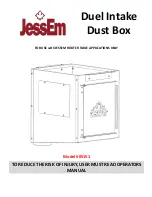
6
READ THIS MANUAL CAREFULLY BEFORE ATTEMPTING TO INSTALL OR OPERATE
THE MODEL V410 UNIT. RETAIN THESE INSTRUCTIONS FOR FUTURE REFERENCE.
SAFETY RULES
Follow all electrical and safety codes as well as the National Electrical Code (NEC), National Fire
Protection Association (NFPA), and the Occupational Safety and Health Act (OSHA). All electrical
connections and wiring should be performed by qualified personnel only.
National Fire Protection Association (NFPA) standards require specific duct design and dust collector
configuration when collecting potentially reactive metal dusts, such as aluminum and magnesium, and other
materials. NFPA also covers other dusts such as grain, plastics, etc. A guideline for determining the
precautions to be taken can be found in NFPA 497. Other NFPA standards may apply to your specific
application. Consult current NFPA standards, available from NFPA, 1 Batterymarch Park, Quincy, MA,
02269, 1-800-344-3555, for applicable safeguards which may required for the Installation, Operation, and
Service of this product.
Fire suppression equipment provided by others.
Additional references are the Uniform Building Code and Uniform Mechanical Code.
WARNING
APPLICATION OF DUST CONTROL EQUIPMENT:
1. Do not mix materials being collected by a dust collector unless it is determined that mixing of materials
does not cause hazardous conditions to occur or creates a condition of operation for which the equipment
was not intended.
2. Under no condition should burning cigarettes or any burning object be allowed into the hood or ducting of
any dust control system.
3. When dust collectors are used to collect emissions from steel or combined metal sanding, the dust
collector should be located an adequate distance away to minimize the chance of ignition of duct system
residue from hot metal chips and sparks. Should further protection from fire be required, adequate duct
systems from capture hoods and dust collector should be provided so that a fire protection specialist can
install extinguishing equipment. You may also want to contact your insurance underwriter.
4. Explosion relief vents may be required per NFPA codes. Explosion vents are used to minimize the
destructive effect of an explosion and are intended primarily to protect from injury anyone in the
immediate area of the collector. Damage to the collector may, or may not, be repairable. Vents installed
on dust control equipment within a building must be vented to the outside to minimize chances of injury to
persons or a secondary explosion. Again, consult the proper authority to determine proper method of
venting. Explosion relief vents are optional and should be ordered with the dust collector or installed
locally.
Содержание V410
Страница 6: ...8 Figure 1...
Страница 19: ...A12 Figure 14 Model V410 filter lifting assembly Figure 15...
Страница 26: ...A19 TYPICAL INSTALLATION WIRING DIAGRAM...
Страница 28: ...A21 PART 4KT1 1096 REV 11 98 A 26 1894...
Страница 29: ......
Страница 32: ...3...
Страница 35: ...5...
Страница 36: ......
Страница 39: ...7 Figure 5 Dual Cartridge with Relay Figure 6 Dual Cartridge without Relay...
Страница 40: ......
Страница 41: ...8 Figure 7 DT 3000 with Relay Figure 8 DT 3000 without Relay...
Страница 42: ...8...
Страница 43: ......
Страница 45: ...9...
Страница 46: ......
Страница 48: ...10...
Страница 49: ......
























